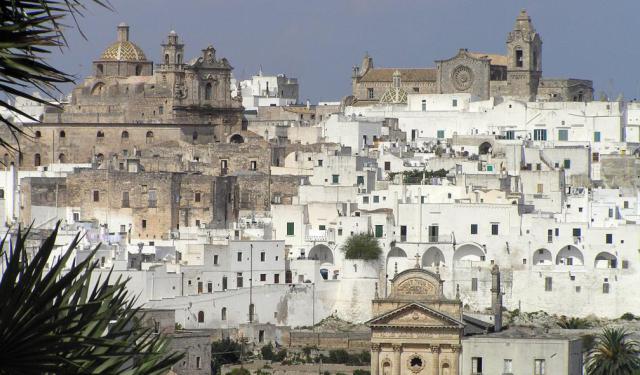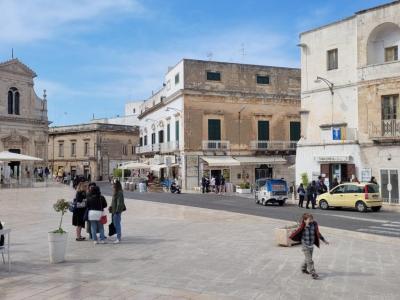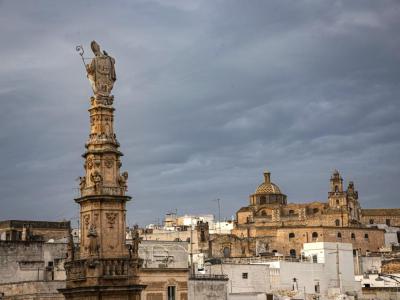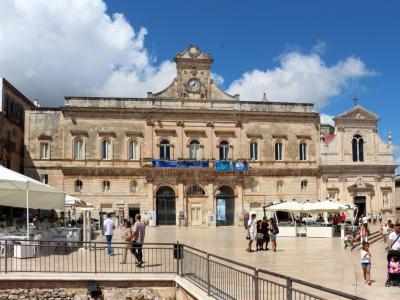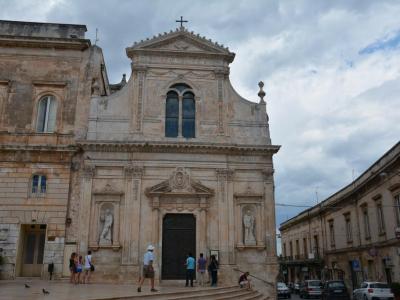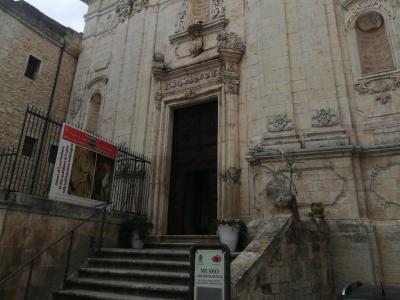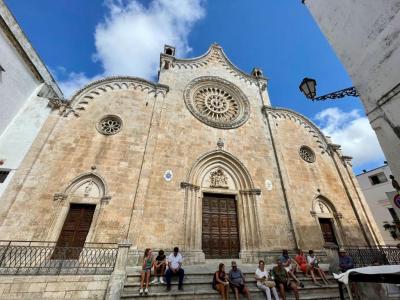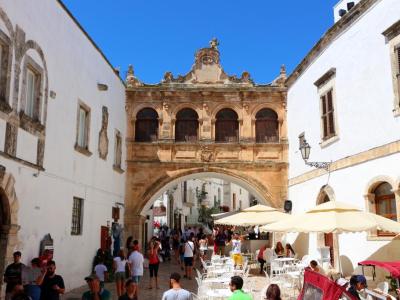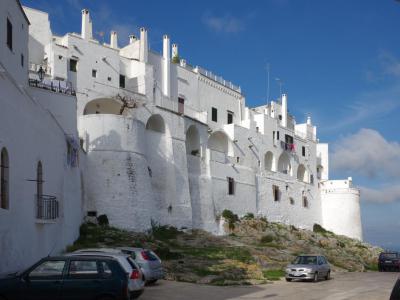Ostuni Introduction Walking Tour (Self Guided), Ostuni
Perched atop a protective hill on the coast of Apulia, Italy, the picturesque town of Ostuni is a veritable maze, with a tapestry of houses upon houses, weaving together centuries of history that no map can adequately convey. In this intricate network of winding alleys, staircases, and arches, history and charm intertwine seamlessly.
The town's name, Ostuni, holds a mystique, with multiple theories on its origin. Some suggest Greek roots (“Astu néon” meaning "new town"), while others propose Latin origins ("Hostium Unio" translating as "a group of people of different origins").
In 996 AD, Ostuni became part of the Norman County of Lecce, leading to the construction of a medieval town complete with a castle and city walls. During the Renaissance, the city thrived under Isabella of Aragon and her daughter, Bona Sforza, who fortified its defenses against Turkish threats.
The golden age of Ostuni arrived with Spanish rule in the 16th century. Honors, fortifications, and cultural growth characterized this period. However, the following century brought a period of decline, marked by financial struggles.
The practice of lime whitewashing the houses (up to the roofs) during that period not only brightened narrow streets but also played a key role in preventing the spread of the plague. Today, it remains a hallmark of this enchanting town, earning it the moniker "White City" or "Nativity Scene City".
Under the Bourbons, in the 18th century, Ostuni expanded and embraced Enlightenment ideals. From World War II onward, the city evolved into a renowned tourist destination.
One of the first sights that greet visitors upon entering Ostuni is the splendid Freedom Square (Piazza della Liberta). It is here that you can also find the iconic Column of Saint Oronzo (Colonna di Sant'Oronzo), dedicated to the town's patron saint, a symbol of spiritual significance for the community.
For those seeking a spiritual experience, the Church of San Francesco (Chiesa di San Francesco) offers a tranquil escape. Another symbol of the town's devotion to its heritage is the Ostuni Cathedral, whose intricate details and serene interior are a true delight for visitors.
Ostuni beckons to travelers as a place that promises an enriching experience. Each corner turned here reveals something new. As you wander, expect surprises: dead-end alleys, charming gardens, fleeting Adriatic sea vistas, verdant doors, and endless blue skies. Embark on a journey to Ostuni now and discover the secrets and wonders that await in this captivating Italian gem. Your exciting adventure is just a step away!
The town's name, Ostuni, holds a mystique, with multiple theories on its origin. Some suggest Greek roots (“Astu néon” meaning "new town"), while others propose Latin origins ("Hostium Unio" translating as "a group of people of different origins").
In 996 AD, Ostuni became part of the Norman County of Lecce, leading to the construction of a medieval town complete with a castle and city walls. During the Renaissance, the city thrived under Isabella of Aragon and her daughter, Bona Sforza, who fortified its defenses against Turkish threats.
The golden age of Ostuni arrived with Spanish rule in the 16th century. Honors, fortifications, and cultural growth characterized this period. However, the following century brought a period of decline, marked by financial struggles.
The practice of lime whitewashing the houses (up to the roofs) during that period not only brightened narrow streets but also played a key role in preventing the spread of the plague. Today, it remains a hallmark of this enchanting town, earning it the moniker "White City" or "Nativity Scene City".
Under the Bourbons, in the 18th century, Ostuni expanded and embraced Enlightenment ideals. From World War II onward, the city evolved into a renowned tourist destination.
One of the first sights that greet visitors upon entering Ostuni is the splendid Freedom Square (Piazza della Liberta). It is here that you can also find the iconic Column of Saint Oronzo (Colonna di Sant'Oronzo), dedicated to the town's patron saint, a symbol of spiritual significance for the community.
For those seeking a spiritual experience, the Church of San Francesco (Chiesa di San Francesco) offers a tranquil escape. Another symbol of the town's devotion to its heritage is the Ostuni Cathedral, whose intricate details and serene interior are a true delight for visitors.
Ostuni beckons to travelers as a place that promises an enriching experience. Each corner turned here reveals something new. As you wander, expect surprises: dead-end alleys, charming gardens, fleeting Adriatic sea vistas, verdant doors, and endless blue skies. Embark on a journey to Ostuni now and discover the secrets and wonders that await in this captivating Italian gem. Your exciting adventure is just a step away!
How it works: Download the app "GPSmyCity: Walks in 1K+ Cities" from Apple App Store or Google Play Store to your mobile phone or tablet. The app turns your mobile device into a personal tour guide and its built-in GPS navigation functions guide you from one tour stop to next. The app works offline, so no data plan is needed when traveling abroad.
Ostuni Introduction Walking Tour Map
Guide Name: Ostuni Introduction Walking Tour
Guide Location: Italy » Ostuni (See other walking tours in Ostuni)
Guide Type: Self-guided Walking Tour (Sightseeing)
# of Attractions: 8
Tour Duration: 1 Hour(s)
Travel Distance: 0.7 Km or 0.4 Miles
Author: DanaOffice
Sight(s) Featured in This Guide:
Guide Location: Italy » Ostuni (See other walking tours in Ostuni)
Guide Type: Self-guided Walking Tour (Sightseeing)
# of Attractions: 8
Tour Duration: 1 Hour(s)
Travel Distance: 0.7 Km or 0.4 Miles
Author: DanaOffice
Sight(s) Featured in This Guide:
- Piazza della Liberta (Freedom Square)
- Colonna di Sant'Oronzo (Column of Saint Oronzo)
- Palazzo del Municipio (Municipal Palace)
- Chiesa di San Francesco d'Assisi (Church of St. Francis of Assisi)
- Museum of Preclassical Civilizations of Southern Murgia
- Duomo di Ostuni (Ostuni Cathedral)
- Arco Scoppa (Scoppa Arch)
- Cinta Muraria di Ostuni (Ostuni City Walls)
1) Piazza della Liberta (Freedom Square) (must see)
Freedom Square stands as the bustling heart of Ostuni, Italy, offering both locals and visitors a vibrant and lively gathering place. Dominating the square's landscape is a majestic 20-meter tall column dating back to the 18th century, graced by a statue of Saint Oronzo, the town's revered patron saint.
This central square provides a delightful blend of historical and culinary experiences. Here, you'll encounter the Palace Municipale, that now serves as the town hall. Freedom Square is also a gastronomic haven. It is home to a plethora of traditional restaurants, quaint cafes, and the occasional gelateria, inviting you to indulge in the delectable flavors of Apulian cuisine.
While dining in the square, it's worth noting that, like many central squares in Italian cities and tourist destinations, the restaurants here often have slightly higher prices than those tucked away on quieter streets. This can manifest in the form of the "coperto," a fixed service charge that can sometimes perplex first-time visitors to Italy. Nevertheless, savoring an authentic Italian meal in this enchanting setting is an experience to remember.
Throughout your visit to Ostuni, you'll naturally find yourself passing through Freedom Square multiple times. However, consider making a deliberate stop in the early evening. This is when both locals and tourists converge on the square for their passeggiata, a leisurely stroll, and to partake in aperitivos or delightful dinners. The square truly comes alive during this time, offering a glimpse into the vibrant and convivial atmosphere that characterizes Ostuni's evenings.
This central square provides a delightful blend of historical and culinary experiences. Here, you'll encounter the Palace Municipale, that now serves as the town hall. Freedom Square is also a gastronomic haven. It is home to a plethora of traditional restaurants, quaint cafes, and the occasional gelateria, inviting you to indulge in the delectable flavors of Apulian cuisine.
While dining in the square, it's worth noting that, like many central squares in Italian cities and tourist destinations, the restaurants here often have slightly higher prices than those tucked away on quieter streets. This can manifest in the form of the "coperto," a fixed service charge that can sometimes perplex first-time visitors to Italy. Nevertheless, savoring an authentic Italian meal in this enchanting setting is an experience to remember.
Throughout your visit to Ostuni, you'll naturally find yourself passing through Freedom Square multiple times. However, consider making a deliberate stop in the early evening. This is when both locals and tourists converge on the square for their passeggiata, a leisurely stroll, and to partake in aperitivos or delightful dinners. The square truly comes alive during this time, offering a glimpse into the vibrant and convivial atmosphere that characterizes Ostuni's evenings.
2) Colonna di Sant'Oronzo (Column of Saint Oronzo) (must see)
The Column of Saint Oronzo, also known as the Spire of Saint Oronzo, is a majestic obelisk situated in Ostuni. This remarkable monument, located in the heart of Freedom Square, was crafted in 1771 by the skilled Ostuni sculptor, Giuseppe Greco. Its construction was driven by deep devotion and profound gratitude towards the city's patron saint, Saint Oronzo, who was revered for saving Ostuni from the devastating plague.
Rising to an impressive height of approximately twenty meters, the Column of Saint Oronzo epitomizes the exuberant Baroque style of the period. The obelisk is composed of four distinct levels, each adorned with intricate details that celebrate the city's devotion to Saint Oronzo. These levels ascend from a sturdy base, culminating in the crowning glory of the statue of Saint Oronzo.
Throughout the column's structure, visitors will encounter a lavish array of decorative elements. Latin phrases, angelic figures, and ornate frames grace its surface, recounting the city's deep-rooted faith. The second level of the obelisk is particularly opulent, featuring a slightly projecting balustrade. Here, at each corner, statues of saints stand sentinel.
Among these saints, one can unmistakably identify Saint Lucia, her image radiating grace and devotion. Accompanying her are a Holy Bishop, believed to be Saint Augustine of Hippo, holding a book of wisdom, and a Jesuit Saint tenderly cradling a child, representing Saint Bernardino Realino of Lecce. The fourth statue, though somewhat fragmented, is attributed to Saint Irene, despite the absence of one arm and the palm of martyrdom.
The Column of Saint Oronzo serves not only as a remarkable work of art but also as a powerful symbol of the city's unwavering faith and enduring gratitude to its patron saint for his protection and benevolence.
Rising to an impressive height of approximately twenty meters, the Column of Saint Oronzo epitomizes the exuberant Baroque style of the period. The obelisk is composed of four distinct levels, each adorned with intricate details that celebrate the city's devotion to Saint Oronzo. These levels ascend from a sturdy base, culminating in the crowning glory of the statue of Saint Oronzo.
Throughout the column's structure, visitors will encounter a lavish array of decorative elements. Latin phrases, angelic figures, and ornate frames grace its surface, recounting the city's deep-rooted faith. The second level of the obelisk is particularly opulent, featuring a slightly projecting balustrade. Here, at each corner, statues of saints stand sentinel.
Among these saints, one can unmistakably identify Saint Lucia, her image radiating grace and devotion. Accompanying her are a Holy Bishop, believed to be Saint Augustine of Hippo, holding a book of wisdom, and a Jesuit Saint tenderly cradling a child, representing Saint Bernardino Realino of Lecce. The fourth statue, though somewhat fragmented, is attributed to Saint Irene, despite the absence of one arm and the palm of martyrdom.
The Column of Saint Oronzo serves not only as a remarkable work of art but also as a powerful symbol of the city's unwavering faith and enduring gratitude to its patron saint for his protection and benevolence.
3) Palazzo del Municipio (Municipal Palace)
The Municipal Palace in Ostuni, boasts a rich history that spans centuries, with its origins deeply intertwined with the city's religious and civic evolution.
Originally, the Municipal Palace was a Franciscan convent, nestled beside the Church of San Francesco D'Assisi. For over five centuries, from 1304 to 1809, it served as a serene residence for the Franciscan friars. The structure is characterized by two distinct levels: the ground floor housed communal spaces utilized by all the friars, while the first floor comprised individual rooms.
In 1813, during the Napoleonic era and amidst the suppression of monastic orders, the convent underwent a significant transformation. It transitioned into the City Palace, a purpose-built edifice intended to house the municipal administration.
During the period from 1861 to 1887, the main facade of the Municipal Palace underwent a modernization process under the guidance of architect Ferdinando Ayroldi. The neoclassical style adopted for this renovation aimed to harmonize the building's aesthetics with the adjacent Church. Since 1887, the former convent has functioned as the official seat of the city's municipality.
Upon entering the Town Hall, visitors encounter the charming cloister, constructed in 1739 under the guidance of engineer Pietro Magarelli. This tranquil space serves as a testament to the building's historical roots.
For those ascending to the first floor via a grand staircase, a visual delight awaits. Here, the works of artist Onofrio Bramante take center stage, offering a captivating depiction of the Historia Apuliae.
Originally, the Municipal Palace was a Franciscan convent, nestled beside the Church of San Francesco D'Assisi. For over five centuries, from 1304 to 1809, it served as a serene residence for the Franciscan friars. The structure is characterized by two distinct levels: the ground floor housed communal spaces utilized by all the friars, while the first floor comprised individual rooms.
In 1813, during the Napoleonic era and amidst the suppression of monastic orders, the convent underwent a significant transformation. It transitioned into the City Palace, a purpose-built edifice intended to house the municipal administration.
During the period from 1861 to 1887, the main facade of the Municipal Palace underwent a modernization process under the guidance of architect Ferdinando Ayroldi. The neoclassical style adopted for this renovation aimed to harmonize the building's aesthetics with the adjacent Church. Since 1887, the former convent has functioned as the official seat of the city's municipality.
Upon entering the Town Hall, visitors encounter the charming cloister, constructed in 1739 under the guidance of engineer Pietro Magarelli. This tranquil space serves as a testament to the building's historical roots.
For those ascending to the first floor via a grand staircase, a visual delight awaits. Here, the works of artist Onofrio Bramante take center stage, offering a captivating depiction of the Historia Apuliae.
4) Chiesa di San Francesco d'Assisi (Church of St. Francis of Assisi) (must see)
The Church of St. Francis of Assis was originally erected in 1304 within the serene surroundings of the "Colombro" garden, a land graciously donated by the Prince of Taranto. Originally designed in the Gothic style, the church underwent profound renovations in 1615, adapting to the changing times while preserving its spiritual essence.
The church's magnificent façade, which captivates visitors today, was masterfully crafted by Gaetano Jurleo in 1883. Its design harmonizes gracefully with the adjacent Palazzo Civico, a structure later constructed by the Archconfraternity of the Immaculate Conception. The façade is divided into two sections, distinguished by a central cornice. At its midpoint, an atypical Romanesque-inspired window graces the façade. Just below the cornice, two Carrara marble statues of Saint Francis of Assisi and Saint Anthony of Padua, sculpted by Francesco Bagnulo, stand sentinel. Between these saints lies a remarkable bronze door, the work of Egidio Giaroli.
The interior, designed by Salvatore Trinchera and Francesco Greco in 1777, exudes an air of reverence. Columns, pilasters, and cornices grace the space, adorned with Corinthian capitals and vaults that support a striking dome. The main altar, dating back to 1780 and crafted from marble, features two lateral angels representing Ecstasy and Meditation. Adjacent to the main altar stands the magnificent organ, a creation of Tommaso Alvano in 1882.
Among the precious statues gracing the church, the Via Crucis figures, dating from the early twentieth century, hold particular significance. Additionally, there are the statues of Saint Joseph with Child (1689) and the wooden representation of the Immaculate Conception (1719), both sculpted by Giacomo Colombo. Bas-reliefs depicting the Via Crucis, skillfully installed in 1989 by Gaetano Valerio, add a further layer of religious symbolism. Notably, the church features a painting portraying Moses breaking the Tablets of the Law in front of the statue of the golden calf.
The church's magnificent façade, which captivates visitors today, was masterfully crafted by Gaetano Jurleo in 1883. Its design harmonizes gracefully with the adjacent Palazzo Civico, a structure later constructed by the Archconfraternity of the Immaculate Conception. The façade is divided into two sections, distinguished by a central cornice. At its midpoint, an atypical Romanesque-inspired window graces the façade. Just below the cornice, two Carrara marble statues of Saint Francis of Assisi and Saint Anthony of Padua, sculpted by Francesco Bagnulo, stand sentinel. Between these saints lies a remarkable bronze door, the work of Egidio Giaroli.
The interior, designed by Salvatore Trinchera and Francesco Greco in 1777, exudes an air of reverence. Columns, pilasters, and cornices grace the space, adorned with Corinthian capitals and vaults that support a striking dome. The main altar, dating back to 1780 and crafted from marble, features two lateral angels representing Ecstasy and Meditation. Adjacent to the main altar stands the magnificent organ, a creation of Tommaso Alvano in 1882.
Among the precious statues gracing the church, the Via Crucis figures, dating from the early twentieth century, hold particular significance. Additionally, there are the statues of Saint Joseph with Child (1689) and the wooden representation of the Immaculate Conception (1719), both sculpted by Giacomo Colombo. Bas-reliefs depicting the Via Crucis, skillfully installed in 1989 by Gaetano Valerio, add a further layer of religious symbolism. Notably, the church features a painting portraying Moses breaking the Tablets of the Law in front of the statue of the golden calf.
5) Museum of Preclassical Civilizations of Southern Murgia
The Museum of Preclassic Civilizations of Southern Murgia is a captivating archaeological museum that offers a journey through the rich history of the region. Initially founded to house archaeological discoveries primarily from the Ostuni countryside, the museum has expanded its collection over time to encompass artifacts from the broader southern Murge area.
Situated within the former Carmelite monastery of Santa Maria Maddalena dei Pazzi, along with the adjoining church of San Vito Martire, the museum opened its doors to the public on May 14, 1989. Since then, it has become a valuable repository of artifacts that shed light on the preclassical civilizations of the Southern Murgia.
One of the focal points of the museum's collection is the array of ceramics, ornaments, flints, stone tools, and other relics that span from the Paleolithic era to the Metal Age. These items offer a glimpse into the daily lives, craftsmanship, and cultural practices of the ancient inhabitants of this region.
Among the museum's most intriguing exhibits is the skeleton of a young woman who tragically died during childbirth. Through careful analysis, researchers have determined that she was approximately 20 years old at the time of her death and was carrying a developing fetus. Her burial site contained various grave goods, including bracelets made from pierced shells on her wrists, a headdress composed of around six hundred mixed Cyclope neritea shells dyed in red ocher, lithic tools, and the remains of animals.
Additionally, the museum boasts an exhibition on the Messapic and Greek inscriptions from the sanctuary of Agnano, offering visitors a deeper understanding of the linguistic and cultural influences that shaped the region's history.
Situated within the former Carmelite monastery of Santa Maria Maddalena dei Pazzi, along with the adjoining church of San Vito Martire, the museum opened its doors to the public on May 14, 1989. Since then, it has become a valuable repository of artifacts that shed light on the preclassical civilizations of the Southern Murgia.
One of the focal points of the museum's collection is the array of ceramics, ornaments, flints, stone tools, and other relics that span from the Paleolithic era to the Metal Age. These items offer a glimpse into the daily lives, craftsmanship, and cultural practices of the ancient inhabitants of this region.
Among the museum's most intriguing exhibits is the skeleton of a young woman who tragically died during childbirth. Through careful analysis, researchers have determined that she was approximately 20 years old at the time of her death and was carrying a developing fetus. Her burial site contained various grave goods, including bracelets made from pierced shells on her wrists, a headdress composed of around six hundred mixed Cyclope neritea shells dyed in red ocher, lithic tools, and the remains of animals.
Additionally, the museum boasts an exhibition on the Messapic and Greek inscriptions from the sanctuary of Agnano, offering visitors a deeper understanding of the linguistic and cultural influences that shaped the region's history.
6) Duomo di Ostuni (Ostuni Cathedral) (must see)
Ostuni Cathedral or Cathedral Basilica of Santa Maria Assunta, is dedicated to the Assumption of the Virgin Mary and holds a rich history. In 1228-1229, under the patronage of Frederick II of Swabia, the cathedral took on its present Romanesque architectural style. It was primarily constructed using pietra gentile, a local stone.
In 1456, an earthquake severely affected the region, including the cathedral. Following this disaster, from 1469 to 1495, the cathedral underwent a thorough reconstruction, embracing a Gothic architectural style.
The cathedral's façade boasts an elegant rose window, a characteristic feature from the 15th century. At one point, there were four such windows gracing the exterior. A notable portal within the façade is dedicated to Saint Blaise (San Biagio), one of the city's beloved patrons, and showcases a finely carved image of the saint.
Inside the cathedral, visitors are treated to a wealth of artistic treasures adorning the ceiling and altars. The Chapel of the Sacred Heart, once dedicated to Saint Cajetan (Gaetano), features a canvas attributed to Domenico Antonio Vaccaro portraying the saint. The Cappellone dell'Immacolata underwent embellishment during the 18th century. The sacristy houses a sizable venerated icon depicting Saint Oronzo.
Additionally, there is a chapel dedicated to the patron saints of Ostuni, namely Saint Blaise, Saint Augustine, Saint Orontius, and Saint Irene. The cathedral once possessed a painting of Santa Lucia by Palma il Giovane, which regrettably was stolen. In the apse, an altarpiece of the Assunta takes center stage, while the chapel of Santa Maria della Sanità features a fresco depicting Saint Catherine of Alexandria. A niche on the counter-façade cradles a 15th-century statue of Christ.
The cathedral's archives are a treasure trove of nearly 200 parchments dating back to the 12th century, providing valuable historical insights.
Recognizing its architectural and historical significance, Ostuni Cathedral was declared a National Monument in 1902.
In 1456, an earthquake severely affected the region, including the cathedral. Following this disaster, from 1469 to 1495, the cathedral underwent a thorough reconstruction, embracing a Gothic architectural style.
The cathedral's façade boasts an elegant rose window, a characteristic feature from the 15th century. At one point, there were four such windows gracing the exterior. A notable portal within the façade is dedicated to Saint Blaise (San Biagio), one of the city's beloved patrons, and showcases a finely carved image of the saint.
Inside the cathedral, visitors are treated to a wealth of artistic treasures adorning the ceiling and altars. The Chapel of the Sacred Heart, once dedicated to Saint Cajetan (Gaetano), features a canvas attributed to Domenico Antonio Vaccaro portraying the saint. The Cappellone dell'Immacolata underwent embellishment during the 18th century. The sacristy houses a sizable venerated icon depicting Saint Oronzo.
Additionally, there is a chapel dedicated to the patron saints of Ostuni, namely Saint Blaise, Saint Augustine, Saint Orontius, and Saint Irene. The cathedral once possessed a painting of Santa Lucia by Palma il Giovane, which regrettably was stolen. In the apse, an altarpiece of the Assunta takes center stage, while the chapel of Santa Maria della Sanità features a fresco depicting Saint Catherine of Alexandria. A niche on the counter-façade cradles a 15th-century statue of Christ.
The cathedral's archives are a treasure trove of nearly 200 parchments dating back to the 12th century, providing valuable historical insights.
Recognizing its architectural and historical significance, Ostuni Cathedral was declared a National Monument in 1902.
7) Arco Scoppa (Scoppa Arch)
The Scoppa Arch is a captivating architectural gem that adds a unique touch to the city's historic center. While it differs in color from the characteristic white buildings of the city, it seamlessly integrates with its surroundings, standing as a testament to Ostuni's rich history and architectural diversity. This charming structure can be found in one of Ostuni's most enchanting squares, Largo Trinchera, serving as a picturesque frame for memorable selfies.
The Scoppa Arch serves as a vital connection between the Bishop's Palace and the Seminary, bridging the two buildings with a touch of elegance and historical significance. Positioned directly in front of the Ostuni Cathedral, it is an iconic landmark that beckons visitors and locals alike to explore its unique beauty.
Originally constructed from wood, the arch underwent a transformation in 1750 under the directive of Cardinal Stoppa. Recognizing the need for greater durability and stability, the decision was made to rebuild the arch using stone. Known simply as "the Loggia," this architectural wonder was inspired by the famous Bridge of Sighs in Venice, adding a touch of Venetian charm to the heart of Ostuni.
One cannot help but be entranced by the Scoppa Arch's geometric elegance. Its design features a pediment that gives the impression of an immense cartouche adorned with a cherubic figure, as well as ornate volutes, shells, and torches that gracefully adorn and frame the upper portion of the arch. This intricate detailing contributes to the arch's aesthetic appeal and ensures it stands as one of the must-see attractions in Ostuni.
The Scoppa Arch serves as a vital connection between the Bishop's Palace and the Seminary, bridging the two buildings with a touch of elegance and historical significance. Positioned directly in front of the Ostuni Cathedral, it is an iconic landmark that beckons visitors and locals alike to explore its unique beauty.
Originally constructed from wood, the arch underwent a transformation in 1750 under the directive of Cardinal Stoppa. Recognizing the need for greater durability and stability, the decision was made to rebuild the arch using stone. Known simply as "the Loggia," this architectural wonder was inspired by the famous Bridge of Sighs in Venice, adding a touch of Venetian charm to the heart of Ostuni.
One cannot help but be entranced by the Scoppa Arch's geometric elegance. Its design features a pediment that gives the impression of an immense cartouche adorned with a cherubic figure, as well as ornate volutes, shells, and torches that gracefully adorn and frame the upper portion of the arch. This intricate detailing contributes to the arch's aesthetic appeal and ensures it stands as one of the must-see attractions in Ostuni.
8) Cinta Muraria di Ostuni (Ostuni City Walls)
The Ostuni City Walls, also known as the "White City" walls, stand as a testament to the rich history and defensive heritage of this captivating Italian town. These ancient fortifications, dating back to the invasion of Angioni, were originally constructed to safeguard the old town of Ostuni from external threats. They represent not only a vital part of Ostuni's architectural landscape but also a link to the town's storied past.
The history of these protective walls is intertwined with various historical events and periods. Following the devastating earthquake of 1456, the Aragonese rulers of the region recognized the importance of restoring and expanding the defensive perimeter of Ostuni. As a result, the city walls underwent significant renovations, reinforcing their role as a safeguard against potential invaders.
One can only imagine the scenes that played out atop these walls during times of siege. From their vantage point, defenders would hurl stones and even boiling oil down upon any adversaries attempting to breach the city's defenses.
The city walls featured four entrances: Porta San Francesco, Porta del Ponte, Porta Nova, and Porta San Demetrio. While the first two have not survived the passage of time, Porta Nova and Porta San Demetrio remain as historic gateways to the old town.
For those who choose to saunter along the city walls, a unique experience awaits. As you walk atop these ancient fortifications, you can take in the serene vistas of the Adriatic Sea, with its shimmering waters extending to the horizon. Below, the checkerboard pattern of olive groves surrounds the old city, offering a picturesque backdrop that enhances the charm of this historic setting.
The history of these protective walls is intertwined with various historical events and periods. Following the devastating earthquake of 1456, the Aragonese rulers of the region recognized the importance of restoring and expanding the defensive perimeter of Ostuni. As a result, the city walls underwent significant renovations, reinforcing their role as a safeguard against potential invaders.
One can only imagine the scenes that played out atop these walls during times of siege. From their vantage point, defenders would hurl stones and even boiling oil down upon any adversaries attempting to breach the city's defenses.
The city walls featured four entrances: Porta San Francesco, Porta del Ponte, Porta Nova, and Porta San Demetrio. While the first two have not survived the passage of time, Porta Nova and Porta San Demetrio remain as historic gateways to the old town.
For those who choose to saunter along the city walls, a unique experience awaits. As you walk atop these ancient fortifications, you can take in the serene vistas of the Adriatic Sea, with its shimmering waters extending to the horizon. Below, the checkerboard pattern of olive groves surrounds the old city, offering a picturesque backdrop that enhances the charm of this historic setting.
The Most Popular Cities
/ view all
